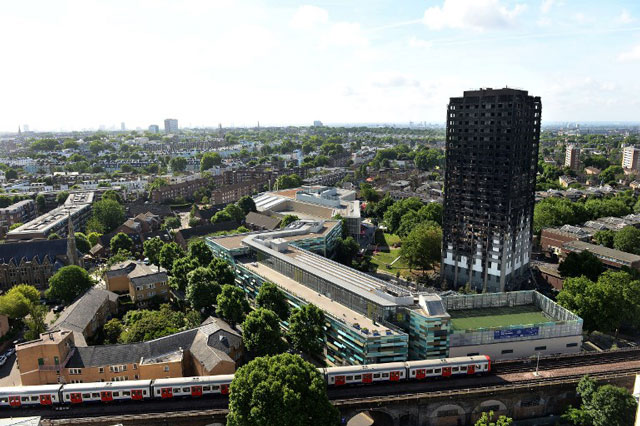
The toll from the London tower block fire has risen to at least 30 people dead and the flames have now been extinguished, police said on June 16, 2017. AFP PHOTO
Toll rises to at least 30 dead in London tower block fire: police
London, United Kingdom | The toll from the London tower block fire has risen to at least 30 people dead and the flames have now been extinguished, police said on Friday.
“We know that at least 30 people have died as a result of this fire,” police commander Stuart Cundy told reporters, adding that the fire was not considered to have been started “deliberately”.
They said this minutes after they confirmed the London tower block fire had been extinguished.
Outrage grows as dozens feared dead in London blaze
Dozens of people are feared dead in the London tower block fire as firefighters continued searching for bodies in the high-rise on Friday amid outrage over the use of cladding blamed for spreading the flames.
Seventeen bodies have been found in the 24-storey Grenfell Tower and more than 70 people are unaccounted for, according to media reports.
Police have warned that some of the victims may never be identified because of the state of the remains.
Firefighters were using drones and sniffer dogs to search the building, saying that some of the upper floors are still inaccessible for humans because of concerns about the stability of the structure.
The area surrounding the council-owned tower has been plastered by desperate relatives with pictures of the missing, from grandparents to young children, and large numbers of volunteers were assisting survivors.
Anger has grown about local residents’ fire safety concerns being ignored for years.
The government has ordered a judge-led inquiry into Wednesday’s disaster but is under pressure to act quickly.
“Something’s gone wrong here, something’s gone drastically wrong,” Communities and Local Government Minister Sajid Javid told BBC radio.
Javid said inspections of similar buildings had been ordered, with particular attention to the modern cladding used to beautify and add an insulation layer to ageing concrete and steel structures.
“We need to do whatever it takes to make people that live in those properties safe: that’s either make the properties safe or find some other accommodation, it has to be done,” he said, adding that survivors from the tower would be re-housed in the local area.
– Syrian refugee victim –
Prime Minister Theresa May has come under criticism for not meeting residents when she visited the site on Thursday and locals yelled questions at mayor Sadiq Khan when he walked through the neighbourhood.
“How many children died? What are you going to do about it?” a young boy asked Khan, as the mayor tried to stop tensions rising further.
“You can see the anger for the community, justifiably so,” Khan said.
“Many people have been saying for some time now, their concerns about the housing we’re talking about now, but also other tower blocks around London.”
The fire forced residents to flee through black smoke down the single stairwell, jump out of windows or even drop their children to safety.
Of the 17 victims found so far, six were outside the tower, while it has not yet been deemed safe enough to recover the 11 bodies found inside.
One of the victims was named as Mohammed Alhajali, a 23-year-old Syrian refugee, who came to Britain in 2014 with his brother.
“Mohammed undertook a dangerous journey to flee war and death in Syria, only to meet it here in the UK, in his own home,” the Syrian Solidarity Campaign said in a statement.
Alhajali, who lived on the 14th floor, was a civil engineering student at West London University.
“His dream was to be able to go back home one day and rebuild Syria,” the campaign group said.
– Cladding ‘banned’ in US –
Questions are growing about how the flames spread so quickly, engulfing the tower’s 120 apartments in what fire chiefs said was an unprecedented blaze.
The focus of criticism is on the cladding fitted to external walls of the 1974 tower as part of a £8.7 million ($11 million, 9.9 million euros) refit completed last year.
According to the BBC, the cladding had a plastic core and was similar to that used by high-rise buildings in France, the United Arab Emirates and Australia, which had also suffered fires that spread.
The Times reported that the type of cladding used on the building was banned in US buildings taller than 40 feet (12.2 metres) because of fire safety fears.
It said the company that manufactured the cladding also made fire-resistant models that cost fractionally more than the standard version.
Harley Facades, which fitted the panels, said in a statement: “At this time, we are not aware of any link between the fire and the exterior cladding.”
In addition to debate over the cladding, questions have also been raised over why there was no sprinkler system in the Grenfell Tower which could have helped stop the fire spreading, or any central smoke alarm system that would have woken sleeping residents.
 The Independent Uganda: You get the Truth we Pay the Price
The Independent Uganda: You get the Truth we Pay the Price



